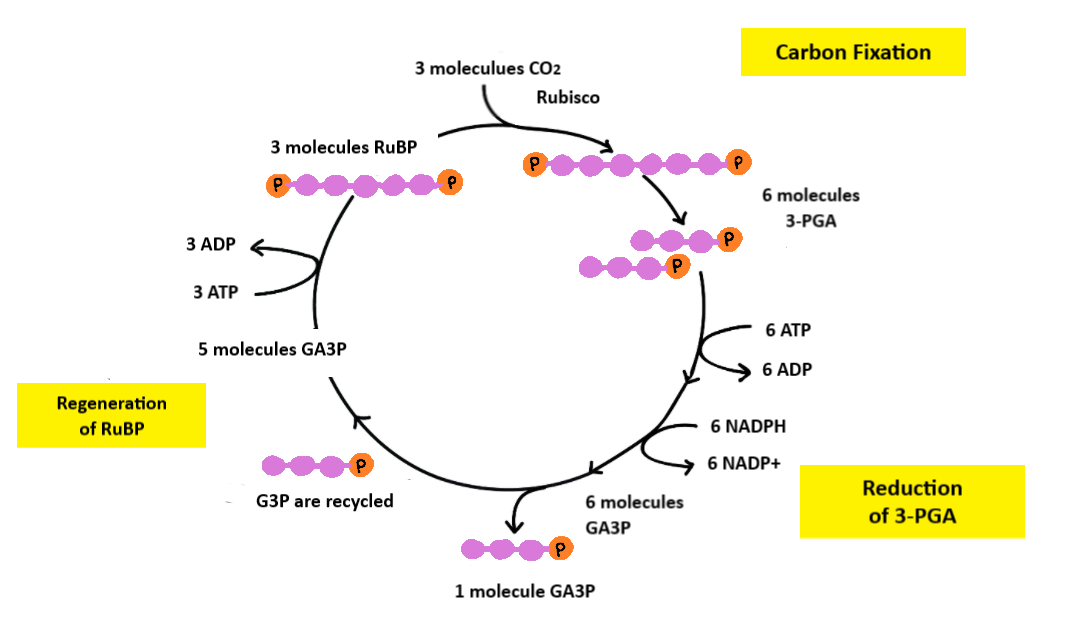
The end product of the Calvin cycle is
a. Ribulose bisphosphate
b. Phosphoglyceraldehyde (PGAL)
c. PEP carboxylase (PEP case)
d. Carbon dioxide
Answer
478.8k+ views
2 likes
Hint: Plant’s produces and stores sucrose as starch. Calvin cycle works in three major steps that are carboxylation, reduction and regeneration to produce sucrose. During each step various products are made. The Calvin cycle consists of various chain reactions to produce sucrose.
Complete answer:
• Calvin cycle is carried out in all photosynthetic plants. Let’s go through all three stages of Calvin cycle.
• The first stage is carboxylation of RuBP (Rubisco bisphosphate). In which the atmospheric
• The second stage is reduction. In this process, 2 molecules of ATP used for phosphorylation and two NADPH for reduction per
• Third stage is regeneration. After the six rounds of Calvin cycle, 2 molecules of PGAL goes for production of one molecule of glucose while another 15 PGAL goes for regeneration of 5-C RuBP that can be used to accept new carbon molecules. This process requires ATP.

Hence, the correct answer is option (B).
Note: Here the regenerated RuBP cannot be the end product because it undergoes regeneration. So the last product should be PGAL. The last product will sucrose instead of glucose because glucose cannot be transported directly to storage by plants. Plant stem can transport sucrose as it is non-reducing sugar and it does not react with oxygen while being transported in the stem for storage. The stored sucrose can be used during dormancy.
Complete answer:
• Calvin cycle is carried out in all photosynthetic plants. Let’s go through all three stages of Calvin cycle.
• The first stage is carboxylation of RuBP (Rubisco bisphosphate). In which the atmospheric
• The second stage is reduction. In this process, 2 molecules of ATP used for phosphorylation and two NADPH for reduction per
• Third stage is regeneration. After the six rounds of Calvin cycle, 2 molecules of PGAL goes for production of one molecule of glucose while another 15 PGAL goes for regeneration of 5-C RuBP that can be used to accept new carbon molecules. This process requires ATP.

Hence, the correct answer is option (B).
Note: Here the regenerated RuBP cannot be the end product because it undergoes regeneration. So the last product should be PGAL. The last product will sucrose instead of glucose because glucose cannot be transported directly to storage by plants. Plant stem can transport sucrose as it is non-reducing sugar and it does not react with oxygen while being transported in the stem for storage. The stored sucrose can be used during dormancy.
Latest Vedantu courses for you
Grade 11 Science PCM | CBSE | SCHOOL | English
CBSE (2025-26)
School Full course for CBSE students
₹41,848 per year
Recently Updated Pages
Express the following as a fraction and simplify a class 7 maths CBSE

The length and width of a rectangle are in ratio of class 7 maths CBSE

The ratio of the income to the expenditure of a family class 7 maths CBSE

How do you write 025 million in scientific notatio class 7 maths CBSE

How do you convert 295 meters per second to kilometers class 7 maths CBSE

Write the following in Roman numerals 25819 class 7 maths CBSE

Trending doubts
State and prove Bernoullis theorem class 11 physics CBSE

What are Quantum numbers Explain the quantum number class 11 chemistry CBSE

Write the differences between monocot plants and dicot class 11 biology CBSE

Who built the Grand Trunk Road AChandragupta Maurya class 11 social science CBSE

1 ton equals to A 100 kg B 1000 kg C 10 kg D 10000 class 11 physics CBSE

State the laws of reflection of light




